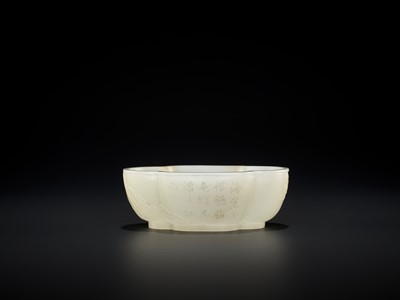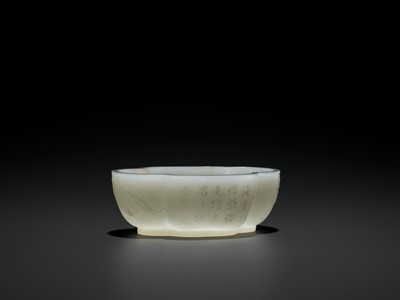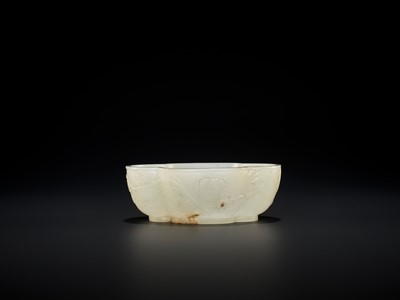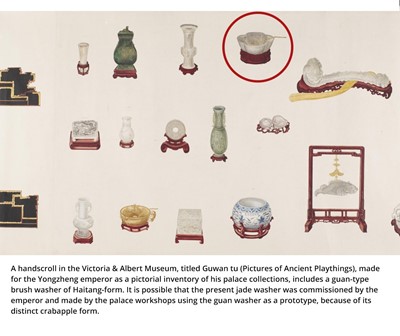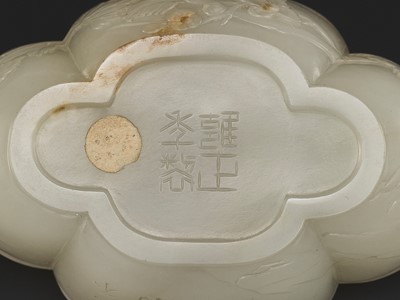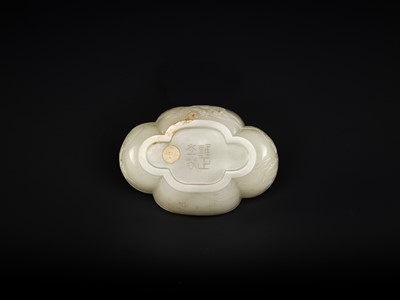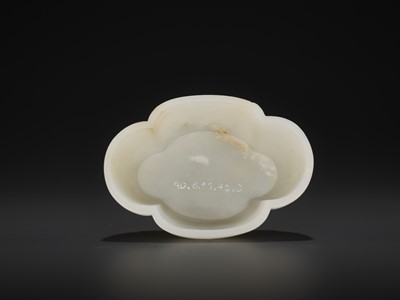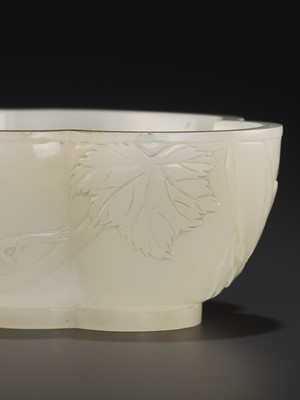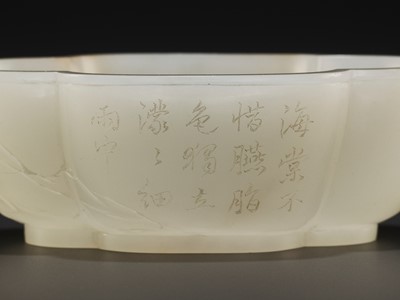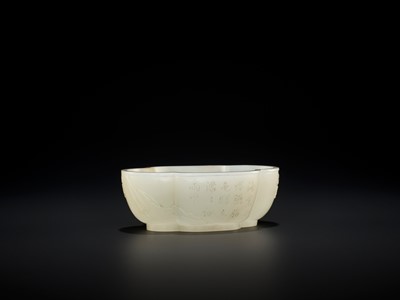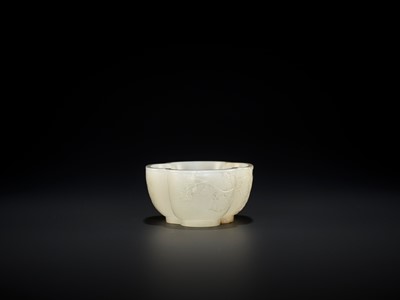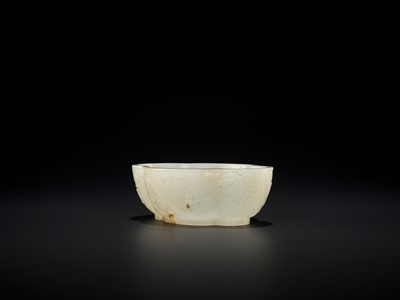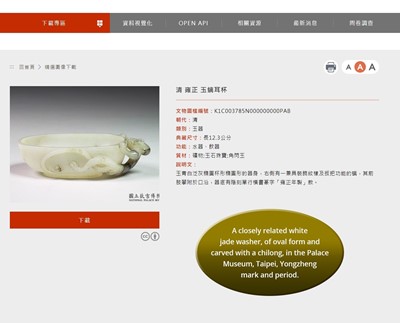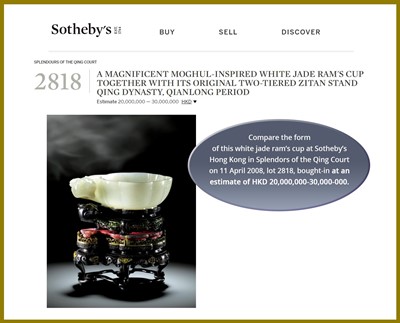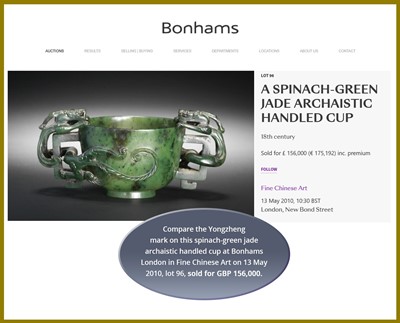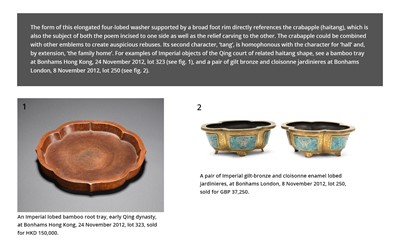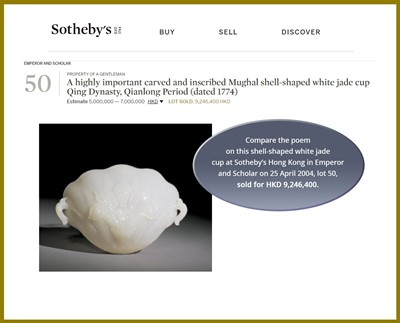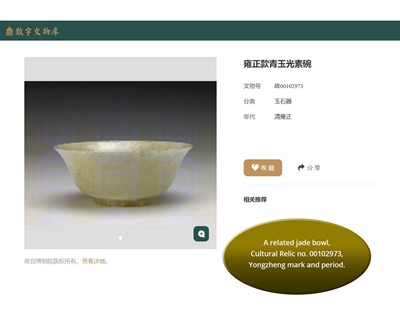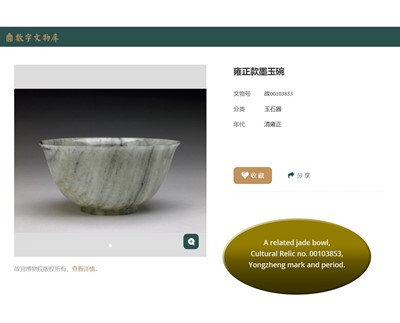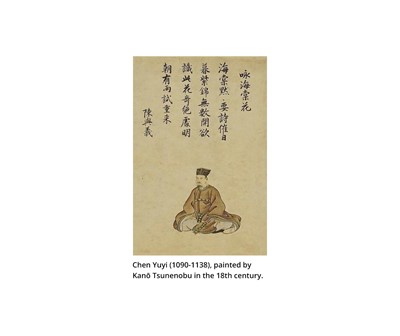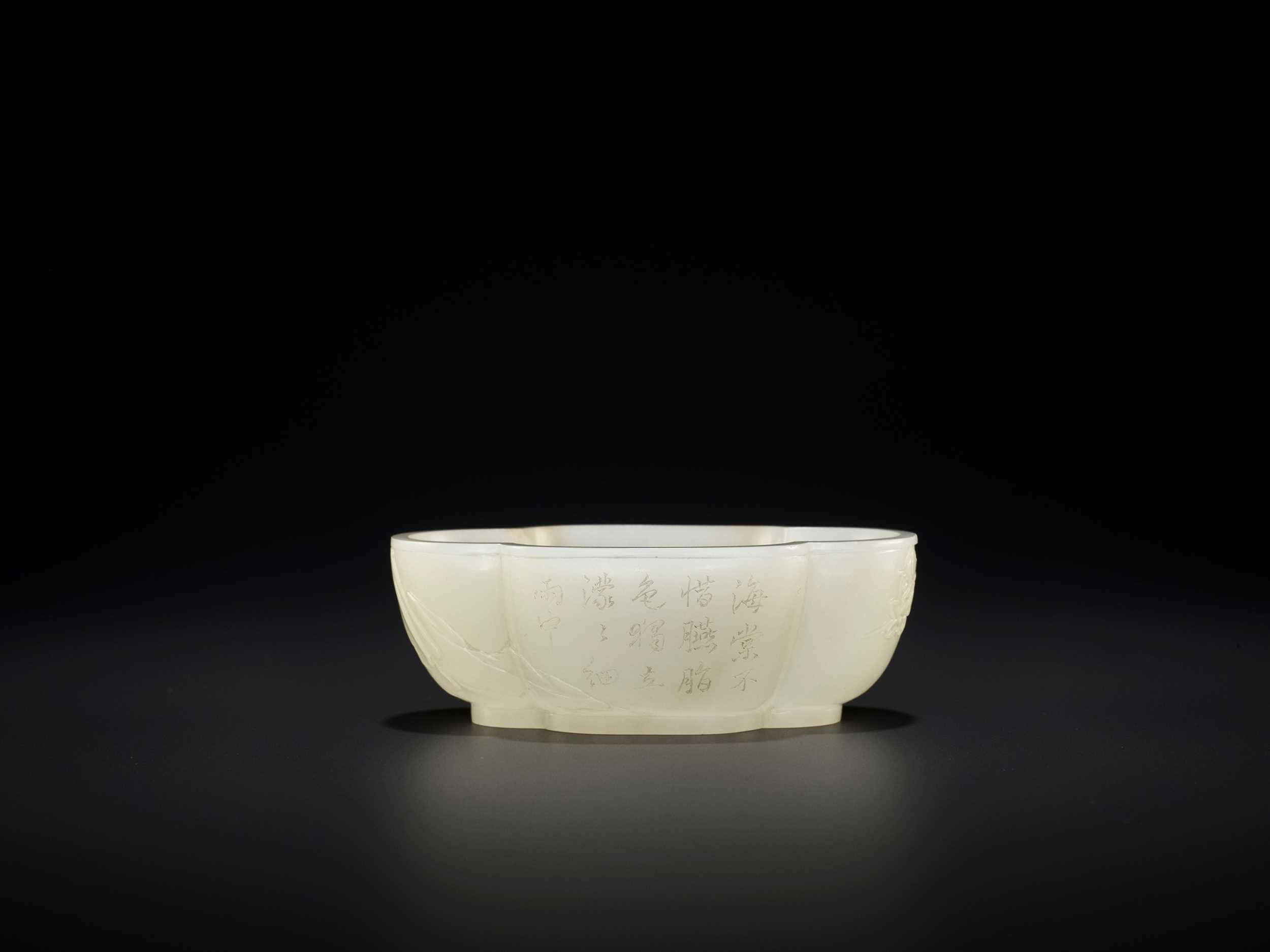5th Mar, 2021 10:00
TWO-DAY AUCTION - Fine Chinese Art / 中國藝術集珍 / Buddhism & Hinduism
63
AN IMPERIAL WHITE JADE ‘HAITANG’ BRUSHWASHER, WITH A POEM BY CHEN YUYI, YONGZHENG MARK AND PERIOD
清雍正款白玉題詩海棠式洗
Sold for €101,120
including Buyer's Premium
China, 1723-1735. Carved to one side in shallow relief with leafy crabapple (haitang) branches, blossoms and small fruit, as well as craggy rockwork, the reverse superbly incised with a poem. The translucent stone of a spectacularly pure white tone with a single russet and cloudy white vein, masterfully incorporated into the depiction. The base neatly incised with a four-character seal mark Yongzheng nianzhi and of the period.
Inscriptions: Two lines from a poem composed by the famous Song Dynasty poet Chen Yuyi (1090-1138), which may be translated as 'the crab apple flower displays its pink blossoms, standing alone in the rain'.
Provenance: A private Danish collection, acquired in Asia prior to 1922, thence by descent within the family. A private collection in Europe, acquired in Sweden prior to 2000. Old illegible collector’s label to base. Old inventory number ’90.635.42.3’ to interior, indicating a prior museum deaccession.
Condition: Excellent condition with minor old wear. Natural flaws to stone.
Weight: 119.5 g
Dimensions: Height 3.4 cm, Length 9.3 cm
A handscroll in the Victoria & Albert Museum, titled Guwan tu (Pictures of Ancient Playthings), made for the Yongzheng emperor as a pictorial inventory of his palace collections, includes a guan-type brush washer of Haitang-form. It is possible that the present jade washer was commissioned by the emperor and made by the palace workshops using the guan washer as a prototype, because of its distinct crabapple form.
The form of this elongated four-lobed washer supported by a broad foot rim directly references the crabapple (haitang), which is also the subject of both the poem incised to one side as well as the relief carving to the other. The crabapple could be combined with other emblems to create auspicious rebuses. Its second character, ‘tang’, is homophonous with the character for ‘hall’ and, by extension, ‘the family home’. For examples of Imperial objects of the Qing court of related haitang shape, see a bamboo tray at Bonhams Hong Kong, 24 November 2012, lot 323 (see fig. 1), and a pair of gilt bronze and cloisonne jardinieres at Bonhams London, 8 November 2012, lot 250 (see fig. 2).
One of the most striking things about the present washer is that the mark on the base is incised with a series of apparently wheel-cut lines to build up the thickness of the strokes in a style very similar to that found on glass objects from the Beijing Palace workshops during the early to mid-Qing dynasty. With this as a clue to provenance, the very slight flaws in the material also indicate a Palace workshops origin, since this is a prominent feature found in a group of jade objects attributable to the court.
The stone shows minuscule inclusions, which is almost hallmark of early Imperial jades, during a time where lapidaries worked by Imperial command striving to create small items of the purest white jade, which began in the Yongzheng period, marking the transition from the mottled pebbles of the Ming dynasty to the flawless white vessels of the Qianlong reign. Hence the most superb jades of the Yongzheng period, such as the present lot, have minuscule flaws which are masterfully integrated into the design and show the absolute highest level of manual polishing of all time, creating a smooth, somewhat ‘oily’ surface with an unctuous feel and lustrous appearance, the latter especially when sunrays shine through the material.
Chen Yuyi (1090-1138) was a poet and politician of the Song dynasty. His biography was included in the History of Song. He composed some of the best shi poetry of the Song era and was a native of Loyang, coming from an official family. He obtained his degree in 1113 and held a number of minor posts before moving to the capital. When North China was invaded by the Jin, he had to flee for his life and his poetry became much more intense and emotionally charged. He returned to official service in the exiled Song court in Hangzhou in 1131.
Jade vessels inscribed with Yongzheng reign marks and of the period are extremely rare. The only published examples from museum collections appear to be a small number preserved in the holdings of the Palace Museum, Beijing. No other Yongzheng reign-marked white jade vessel has been sold ever at a major auction house outside of China.
The Palace Museum, Beijing has published five jade vessels inscribed with Yongzheng reign-marks: a green jade handled cup, a green jade flared bowl, a pale green jade cup, a black and white jade bowl, and a pale green jade brush washer, illustrated in Compendium of Collections in the Palace Museum, Jade. Qing Dynasty, vol. 10, Beijing, 2011, pls 146, 153, 154, 187, and a set of black jade rings, illustrated in Compendium of Collections in the Palace Museum. Jade. Qing Dynasty, vol. 9, Beijing, 2011, pl. 224. The marks are intricately articulated in the same archaic-style seal script in two columns, undoubtedly in the same production process.
Literature comparison: Compare with a related white jade washer, of oval form and carved with a chilong, in the Palace Museum, Taipei (collection number K1C003785N000000000PAB). Compare also with a related pale green jade brush washer, Yongzheng four-character mark and of the period, from the Qing Court Collection, illustrated in the Compendium of Collections in the Palace Museum. Jade 10. Qing Dynasty, Beijing, 2011, p.237, no.187. Compare also with two jade bowls in the Palace Museum, Beijing, with Yongzheng reign marks, Cultural Relic nos. 00103853 and 00102973.
清雍正款白玉題詩海棠式洗
中國, 1723-1735年。海棠式洗呈四瓣海棠之形,曲壁,線條流暢圓潤,圈足隨形。一面淺浮雕多葉的海棠樹,上面可見海棠花與小花骨朵。旁邊假山岩石。背面刻有一首詩。白玉光瑩溫潤,些微赤褐色脈紋,巧妙融入整體。整器造型端莊,雕刻嫻熟。底足可有四字款“雍正年制”。
款識:宋代詩人陳與義(1090-1138):海棠不惜胭脂色/獨立濛濛細雨中
來源:丹麥私人收藏,1922年前購於亞洲,自此保存在同一家族。歐洲私人收藏,2000年前購於瑞典。底部可見老收藏標簽。筆洗内有舊收藏編號“90.635.42.3”,可能是之前博物館收藏所留。
圖片:收藏編號“90.635.42.3”,可能是之前博物館收藏所留。
品相:狀況極佳,輕微使用磨損。玉石自然缺陷。
重量: 119.5 克
尺寸:高3.4 厘米, 9.3 厘米
這件細長的四瓣花口形洗由海棠四出花瓣演變而來,同時也對應了所刻的詩句以及另一面的浮雕花卉。海棠花的"棠"字與"堂"同音,與其他花卉可以組成“玉堂富貴”的意思。清宮也有很多利用海棠進行創作的例子,請參見香港邦瀚斯的御製竹根雕海棠式洗(2012年11月24日,Lot 323)(圖1),以及倫敦邦瀚斯的掐絲琺瑯開光纏枝蓮紋海棠式花盆一對,2012年11月8日,Lot 250(圖2)。
圖片:御製竹根雕海棠式洗, 清初, 香港邦瀚斯, 2012年11月24日, lot 323, 售價HKD 150,000.
圖片:掐絲琺瑯開光纏枝蓮紋海棠式花盆一對, 倫敦邦瀚斯, 2012年11月8日, lot 250, 售價GBP 37,250.
本海棠式洗最引人注目的一件事是,在其底座上的有兩道切割線,以强調玉洗雕工的細緻感,其樣式與北京料器製品相似。這可以作爲出處的一個線索,材料上的細微瑕疵也表明了此洗來自御用工坊的,因為這是根據現有研究發現的宮廷玉器中突出特徵。玉石上略帶皮色,這可以説是早期清代宮廷玉器的特徵。清初,御用工坊努力創造出最純净的白玉小器物。雍正時期是明朝使用的籽料至乾隆年間無瑕的白色器皿的過渡期。 因此,雍正時期最精湛的玉器(如這件白玉洗)具有微小的瑕疵,這些瑕疵被巧妙地運用到設計中,顯示出有史以來最清湛拋光工藝,玉器表面緻密細膩,瑩潤凝脂,尤其是當陽光透過玉料時。
陳與義 (1090-1138) 宋代詩人及政治人物,在宋史中可找到其生平。他是宋代傑出的詩人,洛陽人,出生於士族。1113年中進士,之後擔任不同職位,直至進入首都。北宋敗於金人時,他不得不南遷避難,詩歌變得更加憂國憂民。 1131年,他回到南宋杭州的宮廷繼續任職。
Victoria & Albert Museum有一幅《古物圖》, 描繪了雍正帝的宮廷收藏,包括一件海棠式官窯筆洗,很可能是此次拍品的原型,而這件拍品也很可能也曾存在於雍正帝收藏中。
雍正款的玉器留世極少。博物館藏品中唯一公開發表的例子似乎是保存在北京故宮博物院藏品。在中國以外的大型拍賣行中,沒有其他雍正款白玉器被出售。
北京故宮博物院曾在《故宮博物院藏品大系:玉器編10》中介紹了五件雍正款玉器:青玉雙耳杯,青玉撇口碗,淺青玉杯,黑白玉碗及淺青玉洗(見《故宮博物院藏品大系:玉器編10》,北京2011年,圖146, 153, 154, 187)以及一組墨玉板指,見《故宮博物院藏品大系:玉器編9》,北京,2011年,圖版224。兩玉碗之刻款與現器之銘款均為篆書,形神一致,應出於同一人之手無疑。
文獻比較:一件相近螭龍玉洗,橢圓形,見臺北故宮博物院 (藏品編號K1C003785N000000000PAB);另一件雍正四字款綠玉筆洗見《故宮博物院藏品大系:玉器編10 》,北京2011年,237頁, no 187;北京故宮中還有兩件雍正款素面玉碗(編號 00103853 與 00102973)。
China, 1723-1735. Carved to one side in shallow relief with leafy crabapple (haitang) branches, blossoms and small fruit, as well as craggy rockwork, the reverse superbly incised with a poem. The translucent stone of a spectacularly pure white tone with a single russet and cloudy white vein, masterfully incorporated into the depiction. The base neatly incised with a four-character seal mark Yongzheng nianzhi and of the period.
Inscriptions: Two lines from a poem composed by the famous Song Dynasty poet Chen Yuyi (1090-1138), which may be translated as 'the crab apple flower displays its pink blossoms, standing alone in the rain'.
Provenance: A private Danish collection, acquired in Asia prior to 1922, thence by descent within the family. A private collection in Europe, acquired in Sweden prior to 2000. Old illegible collector’s label to base. Old inventory number ’90.635.42.3’ to interior, indicating a prior museum deaccession.
Condition: Excellent condition with minor old wear. Natural flaws to stone.
Weight: 119.5 g
Dimensions: Height 3.4 cm, Length 9.3 cm
A handscroll in the Victoria & Albert Museum, titled Guwan tu (Pictures of Ancient Playthings), made for the Yongzheng emperor as a pictorial inventory of his palace collections, includes a guan-type brush washer of Haitang-form. It is possible that the present jade washer was commissioned by the emperor and made by the palace workshops using the guan washer as a prototype, because of its distinct crabapple form.
The form of this elongated four-lobed washer supported by a broad foot rim directly references the crabapple (haitang), which is also the subject of both the poem incised to one side as well as the relief carving to the other. The crabapple could be combined with other emblems to create auspicious rebuses. Its second character, ‘tang’, is homophonous with the character for ‘hall’ and, by extension, ‘the family home’. For examples of Imperial objects of the Qing court of related haitang shape, see a bamboo tray at Bonhams Hong Kong, 24 November 2012, lot 323 (see fig. 1), and a pair of gilt bronze and cloisonne jardinieres at Bonhams London, 8 November 2012, lot 250 (see fig. 2).
One of the most striking things about the present washer is that the mark on the base is incised with a series of apparently wheel-cut lines to build up the thickness of the strokes in a style very similar to that found on glass objects from the Beijing Palace workshops during the early to mid-Qing dynasty. With this as a clue to provenance, the very slight flaws in the material also indicate a Palace workshops origin, since this is a prominent feature found in a group of jade objects attributable to the court.
The stone shows minuscule inclusions, which is almost hallmark of early Imperial jades, during a time where lapidaries worked by Imperial command striving to create small items of the purest white jade, which began in the Yongzheng period, marking the transition from the mottled pebbles of the Ming dynasty to the flawless white vessels of the Qianlong reign. Hence the most superb jades of the Yongzheng period, such as the present lot, have minuscule flaws which are masterfully integrated into the design and show the absolute highest level of manual polishing of all time, creating a smooth, somewhat ‘oily’ surface with an unctuous feel and lustrous appearance, the latter especially when sunrays shine through the material.
Chen Yuyi (1090-1138) was a poet and politician of the Song dynasty. His biography was included in the History of Song. He composed some of the best shi poetry of the Song era and was a native of Loyang, coming from an official family. He obtained his degree in 1113 and held a number of minor posts before moving to the capital. When North China was invaded by the Jin, he had to flee for his life and his poetry became much more intense and emotionally charged. He returned to official service in the exiled Song court in Hangzhou in 1131.
Jade vessels inscribed with Yongzheng reign marks and of the period are extremely rare. The only published examples from museum collections appear to be a small number preserved in the holdings of the Palace Museum, Beijing. No other Yongzheng reign-marked white jade vessel has been sold ever at a major auction house outside of China.
The Palace Museum, Beijing has published five jade vessels inscribed with Yongzheng reign-marks: a green jade handled cup, a green jade flared bowl, a pale green jade cup, a black and white jade bowl, and a pale green jade brush washer, illustrated in Compendium of Collections in the Palace Museum, Jade. Qing Dynasty, vol. 10, Beijing, 2011, pls 146, 153, 154, 187, and a set of black jade rings, illustrated in Compendium of Collections in the Palace Museum. Jade. Qing Dynasty, vol. 9, Beijing, 2011, pl. 224. The marks are intricately articulated in the same archaic-style seal script in two columns, undoubtedly in the same production process.
Literature comparison: Compare with a related white jade washer, of oval form and carved with a chilong, in the Palace Museum, Taipei (collection number K1C003785N000000000PAB). Compare also with a related pale green jade brush washer, Yongzheng four-character mark and of the period, from the Qing Court Collection, illustrated in the Compendium of Collections in the Palace Museum. Jade 10. Qing Dynasty, Beijing, 2011, p.237, no.187. Compare also with two jade bowls in the Palace Museum, Beijing, with Yongzheng reign marks, Cultural Relic nos. 00103853 and 00102973.
清雍正款白玉題詩海棠式洗
中國, 1723-1735年。海棠式洗呈四瓣海棠之形,曲壁,線條流暢圓潤,圈足隨形。一面淺浮雕多葉的海棠樹,上面可見海棠花與小花骨朵。旁邊假山岩石。背面刻有一首詩。白玉光瑩溫潤,些微赤褐色脈紋,巧妙融入整體。整器造型端莊,雕刻嫻熟。底足可有四字款“雍正年制”。
款識:宋代詩人陳與義(1090-1138):海棠不惜胭脂色/獨立濛濛細雨中
來源:丹麥私人收藏,1922年前購於亞洲,自此保存在同一家族。歐洲私人收藏,2000年前購於瑞典。底部可見老收藏標簽。筆洗内有舊收藏編號“90.635.42.3”,可能是之前博物館收藏所留。
圖片:收藏編號“90.635.42.3”,可能是之前博物館收藏所留。
品相:狀況極佳,輕微使用磨損。玉石自然缺陷。
重量: 119.5 克
尺寸:高3.4 厘米, 9.3 厘米
這件細長的四瓣花口形洗由海棠四出花瓣演變而來,同時也對應了所刻的詩句以及另一面的浮雕花卉。海棠花的"棠"字與"堂"同音,與其他花卉可以組成“玉堂富貴”的意思。清宮也有很多利用海棠進行創作的例子,請參見香港邦瀚斯的御製竹根雕海棠式洗(2012年11月24日,Lot 323)(圖1),以及倫敦邦瀚斯的掐絲琺瑯開光纏枝蓮紋海棠式花盆一對,2012年11月8日,Lot 250(圖2)。
圖片:御製竹根雕海棠式洗, 清初, 香港邦瀚斯, 2012年11月24日, lot 323, 售價HKD 150,000.
圖片:掐絲琺瑯開光纏枝蓮紋海棠式花盆一對, 倫敦邦瀚斯, 2012年11月8日, lot 250, 售價GBP 37,250.
本海棠式洗最引人注目的一件事是,在其底座上的有兩道切割線,以强調玉洗雕工的細緻感,其樣式與北京料器製品相似。這可以作爲出處的一個線索,材料上的細微瑕疵也表明了此洗來自御用工坊的,因為這是根據現有研究發現的宮廷玉器中突出特徵。玉石上略帶皮色,這可以説是早期清代宮廷玉器的特徵。清初,御用工坊努力創造出最純净的白玉小器物。雍正時期是明朝使用的籽料至乾隆年間無瑕的白色器皿的過渡期。 因此,雍正時期最精湛的玉器(如這件白玉洗)具有微小的瑕疵,這些瑕疵被巧妙地運用到設計中,顯示出有史以來最清湛拋光工藝,玉器表面緻密細膩,瑩潤凝脂,尤其是當陽光透過玉料時。
陳與義 (1090-1138) 宋代詩人及政治人物,在宋史中可找到其生平。他是宋代傑出的詩人,洛陽人,出生於士族。1113年中進士,之後擔任不同職位,直至進入首都。北宋敗於金人時,他不得不南遷避難,詩歌變得更加憂國憂民。 1131年,他回到南宋杭州的宮廷繼續任職。
Victoria & Albert Museum有一幅《古物圖》, 描繪了雍正帝的宮廷收藏,包括一件海棠式官窯筆洗,很可能是此次拍品的原型,而這件拍品也很可能也曾存在於雍正帝收藏中。
雍正款的玉器留世極少。博物館藏品中唯一公開發表的例子似乎是保存在北京故宮博物院藏品。在中國以外的大型拍賣行中,沒有其他雍正款白玉器被出售。
北京故宮博物院曾在《故宮博物院藏品大系:玉器編10》中介紹了五件雍正款玉器:青玉雙耳杯,青玉撇口碗,淺青玉杯,黑白玉碗及淺青玉洗(見《故宮博物院藏品大系:玉器編10》,北京2011年,圖146, 153, 154, 187)以及一組墨玉板指,見《故宮博物院藏品大系:玉器編9》,北京,2011年,圖版224。兩玉碗之刻款與現器之銘款均為篆書,形神一致,應出於同一人之手無疑。
文獻比較:一件相近螭龍玉洗,橢圓形,見臺北故宮博物院 (藏品編號K1C003785N000000000PAB);另一件雍正四字款綠玉筆洗見《故宮博物院藏品大系:玉器編10 》,北京2011年,237頁, no 187;北京故宮中還有兩件雍正款素面玉碗(編號 00103853 與 00102973)。
Zacke Live Online Bidding
Our online bidding platform makes it easier than ever to bid in our auctions! When you bid through our website, you can take advantage of our premium buyer's terms without incurring any additional online bidding surcharges.
To bid live online, you'll need to create an online account. Once your account is created and your identity is verified, you can register to bid in an auction up to 12 hours before the auction begins.
Intended Spend and Bid Limits
When you register to bid in an online auction, you will need to share your intended maximum spending budget for the auction. We will then review your intended spend and set a bid limit for you. Once you have pre-registered for a live online auction, you can see your intended spend and bid limit by going to 'Account Settings' and clicking on 'Live Bidding Registrations'.
Your bid limit will be the maximum amount you can bid during the auction. Your bid limit is for the hammer price and is not affected by the buyer’s premium and VAT. For example, if you have a bid limit of €1,000 and place two winning bids for €300 and €200, then you will only be able to bid €500 for the rest of the auction. If you try to place a bid that is higher than €500, you will not be able to do so.
Online Absentee and Telephone Bids
You can now leave absentee and telephone bids on our website!
Absentee Bidding
Once you've created an account and your identity is verified, you can leave your absentee bid directly on the lot page. We will contact you when your bids have been confirmed.
Telephone Bidding
Once you've created an account and your identity is verified, you can leave telephone bids online. We will contact you when your bids have been confirmed.
Classic Absentee and Telephone Bidding Form
You can still submit absentee and telephone bids by email or fax if you prefer. Simply fill out the Absentee Bidding/Telephone bidding form and return it to us by email at office@zacke.at or by fax at +43 (1) 532 04 52 20. You can download the PDF from our Upcoming Auctions page.
How-To Guides
How to Create Your Personal Zacke Account
How to Register to Bid on Zacke Live
How to Leave Absentee Bids Online
How to Leave Telephone Bids Online
中文版本的操作指南
创建新账号
注册Zacke Live在线直播竞拍(免平台费)
缺席投标和电话投标
Third-Party Bidding
We partner with best-in-class third-party partners to make it easy for you to bid online in the channel of your choice. Please note that if you bid with one of our third-party online partners, then there will be a live bidding surcharge on top of your final purchase price. You can find all of our fees here. Here's a full list of our third-party partners:
- 51 Bid Live
- EpaiLive
- ArtFoxLive
- Invaluable
- LiveAuctioneers
- the-saleroom
- lot-tissimo
- Drouot
Please note that we place different auctions on different platforms. For example, in general, we only place Chinese art auctions on 51 Bid Live.
Bidding in Person
You must register to bid in person and will be assigned a paddle at the auction. Please contact us at office@zacke.at or +43 (1) 532 04 52 for the latest local health and safety guidelines.
